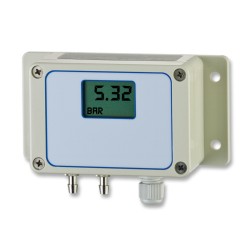 Low range pressure transducers and transmitters for measuring draft air pressure in air handling systems.
Low range pressure transducers and transmitters for measuring draft air pressure in air handling systems.
Draft pressure sensors are used to measure the amount of vacuum or suction pressure generated by air moving or expanding through an air duct, ventilation shaft, flue or chimney.
Draft pressure is typically measured in inches of water column, millibar or pascals pressure units.
A draft differential pressure sensors has two ports for measuring the difference between two positions, across which the draft is generated.
A draft gauge pressure sensor will measure the draft pressure relative to the local atmospheric pressure, and depending on the installation can be configured as positive or negative gauge pressure sensor.
If the draft air can move in the reverse direction, then a differential or gauge reference pressure sensor can be scaled with a bi-directional range such as -6 to +6 mbar so that the draft air pressure can be measured in both directions.
Products
 DPS300 User Switchable Pressure Range, Volts or Current Output Low DP Sensor - The DPS 300 is a low range HVAC differential pressure sensor. The lowest possible pressure range is 0...100 pascals. 2 or 3 switchable pressure ranges, plus volts or current output are included with most standard configurations.
DPS300 User Switchable Pressure Range, Volts or Current Output Low DP Sensor - The DPS 300 is a low range HVAC differential pressure sensor. The lowest possible pressure range is 0...100 pascals. 2 or 3 switchable pressure ranges, plus volts or current output are included with most standard configurations.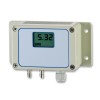 DPS200 HVAC Differential Pressure Transmitter - Differential air pressure sensor with a 10 volt or a 4-20mA output for building ventilation applications. Ranges from 0 to 6 mbar up to 0 to 1000 mbar.
DPS200 HVAC Differential Pressure Transmitter - Differential air pressure sensor with a 10 volt or a 4-20mA output for building ventilation applications. Ranges from 0 to 6 mbar up to 0 to 1000 mbar.
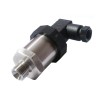 IMPLR Low Range All Stainless Steel OEM Pressure Sensor
IMPLR Low Range All Stainless Steel OEM Pressure Sensor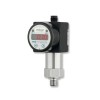 DS210 Combined Low Pressure Switch, Indicator and Sensor
DS210 Combined Low Pressure Switch, Indicator and Sensor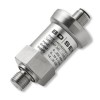 DMP343 Low Range Pneumatic Pressure Sensor
DMP343 Low Range Pneumatic Pressure Sensor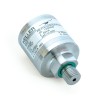 41X Low Range Digital Output Pressure Sensor
41X Low Range Digital Output Pressure Sensor
Applications
 Portable data acquisition trolley +/-20 kPa dp RS485 Modbus RTU interface air pressure sensor and display package - A digital display, pressure sensor and digital interface module package for use on portable data acquisition trolleys to measure pressure of air over a range of -20 to 20 kPa diff from two 6.6mm dia x 11mm barbed hose connections, and sending the corresponding reading via a RS485 Modbus RTU interface through the terminal block connector electrical connections.
Portable data acquisition trolley +/-20 kPa dp RS485 Modbus RTU interface air pressure sensor and display package - A digital display, pressure sensor and digital interface module package for use on portable data acquisition trolleys to measure pressure of air over a range of -20 to 20 kPa diff from two 6.6mm dia x 11mm barbed hose connections, and sending the corresponding reading via a RS485 Modbus RTU interface through the terminal block connector electrical connections. -3 to 3 psi dp range high accuracy 4-20mA air pressure transmitter for water treatment use - A high accuracy low bi-directional range differential pressure transmitter for water treatment use to measure pressure of air over a range of -3 to 3 psi differential from two 1/4”-18 NPT internal process connections, and sending the corresponding 4-20mA signal through the 1/2" NPT internal cable gland electrical connection.
-3 to 3 psi dp range high accuracy 4-20mA air pressure transmitter for water treatment use - A high accuracy low bi-directional range differential pressure transmitter for water treatment use to measure pressure of air over a range of -3 to 3 psi differential from two 1/4”-18 NPT internal process connections, and sending the corresponding 4-20mA signal through the 1/2" NPT internal cable gland electrical connection.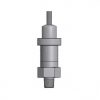 -2 to 2 inHg g 4-20mA out intake and exhaust air pressure sensor for building management use - A high accuracy bidirectional range gauge pressure sensor for building management use to measure pressure of air intake and exhaust over a range of -2 to 2 inHg g from the 1/4 NPT male process connection, and sending the corresponding 4-20mA signal through the waterproof cable electrical connection.
-2 to 2 inHg g 4-20mA out intake and exhaust air pressure sensor for building management use - A high accuracy bidirectional range gauge pressure sensor for building management use to measure pressure of air intake and exhaust over a range of -2 to 2 inHg g from the 1/4 NPT male process connection, and sending the corresponding 4-20mA signal through the waterproof cable electrical connection.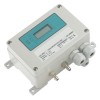 -200 to 200 Pa bi-directional range 4-20mA output dp pressure transmitter for venturi tube - A bidirectional low range pressure transmitter for venturi tube use to measure pressure of air in a venturi tube over a range of -200 to 200 Pa from the 6.6mm dia x 11mm barbed connections process connection, and sending the corresponding 4-20mA signal through the M12 x 1.5 cable glands with 5 internal screw terminals electrical connection.
-200 to 200 Pa bi-directional range 4-20mA output dp pressure transmitter for venturi tube - A bidirectional low range pressure transmitter for venturi tube use to measure pressure of air in a venturi tube over a range of -200 to 200 Pa from the 6.6mm dia x 11mm barbed connections process connection, and sending the corresponding 4-20mA signal through the M12 x 1.5 cable glands with 5 internal screw terminals electrical connection.
 -0.1 to +0.1 inH2O g range 4-20mA signal air pressure sensor and display for pharmaceutical manufacturing use
-0.1 to +0.1 inH2O g range 4-20mA signal air pressure sensor and display for pharmaceutical manufacturing use 1 inH2O differential intrinsically safe 4-20mA out air pressure sensor for HVAC use
1 inH2O differential intrinsically safe 4-20mA out air pressure sensor for HVAC use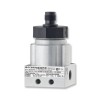 5 psi dp 0-10V out air pressure sensor for automation flow rate testing use on a 15psi line
5 psi dp 0-10V out air pressure sensor for automation flow rate testing use on a 15psi line 20 mbarg digital display air pressure indicator and transmitter with 1/4 NPT male fitting
20 mbarg digital display air pressure indicator and transmitter with 1/4 NPT male fitting 100mbar dp range 0-5Vdc amplified output air pressure sensor for aerospace research test rig use
100mbar dp range 0-5Vdc amplified output air pressure sensor for aerospace research test rig use -20 to 20 inH2O g compound range 0-10Vdc output air pressure sensor for oem use
-20 to 20 inH2O g compound range 0-10Vdc output air pressure sensor for oem use 10Pa diff range 0-20mA output air pressure sensor for automotive component testing
10Pa diff range 0-20mA output air pressure sensor for automotive component testing 20 Pa DP range 0-10V output air pressure sensor for building management use
20 Pa DP range 0-10V output air pressure sensor for building management use
- 5 inH2O g range 4-20mA output air pressure sensor for air cleaning use
- Minus 0.25 inWG differential pressure transmitter for negative air pressure difference
- Industrial powder duct pressure transmitter with +/-15 kPa range
- Dust zone intrinsically safe 3000 Pa air pressure transmitter
- 50 mbar ATEX approved air duct pressure sensor
- -10 to +10 inH2O Air Pressure Sensor for Ventilation & Extraction
- ATEX rated room ±100 Pa differential pressure transmitter
- 1kPa diff pressure transducer for building air ventilation monitoring
- 1.5 inWG differential pressure transducer to control positive pressure inside a building
- Bi-directional -20 to +100 Pa clean room air diff pressure transmitter
- 100 Pa bi-directional range differential air pressure transmitter
- 0.06 inWG positive air pressure transmitter for HVAC blower fan control
